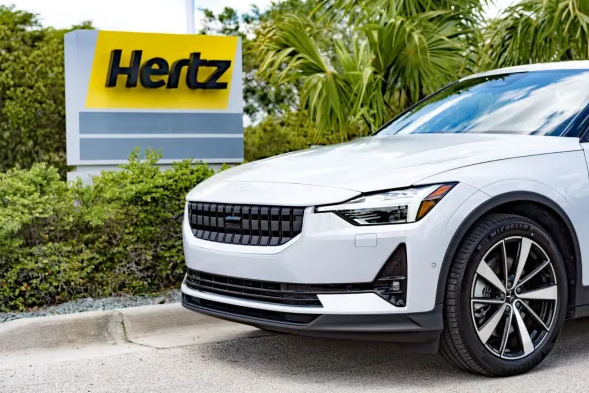A car trip during the summer holidays often begins in the least picturesque place on the entire route: a rental kiosk at the airport.
Surprisingly, it’s common to find electric cars there for the same price (sometimes cheaper) as a Toyota Camry. In fact, they’re sometimes available right away, which is tempting if the other choice is to wait for a gasoline model.
Electric cars don’t pollute and are often more fun to drive than their petrol counterparts. But is it a good idea to rent one for a few days?
To find out, I rented a 2023 Polestar 2 at the San Francisco airport—for about the same price as a Mazda3—and drove to a cabin 135 miles away. Here’s what you need to know before you rent.
1. Take a look before
The controls on the screen (and even the door handles) are strange, at first. Some rental companies provide advice and documentation, so take advantage of it before you hit the road. But there are all sorts of small differences between electric cars and gasoline-powered cars.
So here’s a tip: do some research on the model you want to rent before you arrive at the counter.
Personally, I’ve wanted to try a Polestar for a long time, but I could have gone with a smaller car like the Chevrolet Bolt, which is cheaper. If I had to do it again, I’d probably rent a standard-range Tesla Model 3, for $5 more per day (all amounts in this article are in U.S. dollars).
With the adapter (in the glove compartment), the Model 3 can charge at all public stations, but also at the thousands of Tesla Supercharger stations in Canada and the United States.
2. Your insurance coverage
Some credit cards include free damage or theft insurance for rental cars. This is a good deal, especially since the cost of insuring an electric car with Hertz and Avis is higher than for gasoline vehicles. But be careful, insurance varies by credit card: electric cars are not necessarily covered.
Some cards have a fine print clause for expensive or exotic vehicles, which includes electric vehicles, even models as non-exotic as the Chevrolet Bolt. Check with your credit card issuer.
3. Plan your route
Most electric cars’ GPS devices can find nearby charging stations, but if you’re going far away—or off the beaten track—it’s a good idea to locate charging stations along your route in advance.
Google Maps is good for this: it shows the stations on the route, the number of terminals in each of them, and it identifies the most powerful ones (fast charging stations). And there is also the Electric Circuit website.
By locating the stations in advance, you will take the opportunity to familiarize yourself with the different companies you will encounter. Each has its own application and account. Some offer discounts on charging if you subscribe (even temporarily) to modest monthly subscriptions.
I confess that I didn’t open an account in advance and ended up paying about $70 over four days for a 400-mile drive, roughly what I would have paid for gas in California driving a Mazda 3. I simply paid on the credit card readers at the chargers, which wasn’t always easy (some didn’t work; more on that later).
Take the weather into account. In very hot weather, charging may take longer. This is because software slows down the charging to prevent the battery from overheating.
4. No need to recharge to 100%
In general, charging slows down beyond 80%. After that, the process can slow down considerably (this preserves the battery’s durability). If there are many stations on your route, you can save time by continuing on the road as soon as the battery indicates 80%.
But if charging stations are scarce, it’s better to wait and collect all the autonomy you can. Tell yourself that it’s less time than waiting for roadside assistance on the shoulder with a dead battery.
5. Expect the unexpected
Even if you go to a place that seems to be full of charging stations, don’t get too comfortable: some don’t work as well as others.
One night, I went to charge my Polestar at a ChargePoint station outside a Target store in Stockton, California—a far from isolated area. Not only did the system not charge the car, it got stuck in a weird loop where I couldn’t end the charging session, even though the station already thought the process was complete. It took about 20 minutes of troubleshooting, then a call to ChargePoint customer service to reboot the station and unjam the charger.

CHARGEPOINT PHOTO, VIA REUTERS
A ChargePoint station in Sunnyvale, California
I then tried a BP Pulse charger at a gas station I had used successfully before, but this time it refused to recognize my credit cards. (The same thing happened the last time I charged at that station, but it finally worked for reasons I still don’t understand.) Second take.
Eventually, I drove to an Electrify America charging station across from a Walmart, which was thankfully straightforward. In my experience, Electrify America stations are the most reliable: they don’t require you to create an account or install an app, and they’re the least fussy about credit cards.
6. You must recharge the car before returning it.
Allow time before returning your rental car. As with gasoline vehicles, there will be a fee if you return your electric rental car with a dead battery. And “filling up” takes longer with an electric.
Except, fortunately, “full” in this case doesn’t mean a battery that’s 100% charged. At Avis, the magic number is 70%. At Hertz, the battery must be at least at the same level as when you picked it up, but they give you a little leeway: if it’s 5% or less short of the starting charge, there’s no extra charge.
Read this article in its original version (in English; subscription required).
